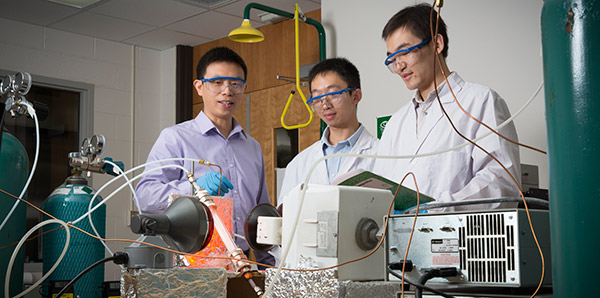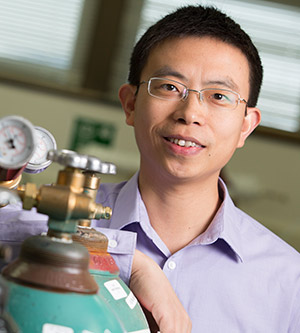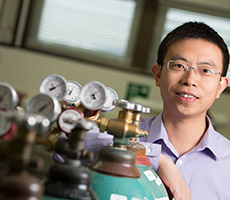
While scientists and engineers race to find new forms of green energy, strategies to reduce atmospheric carbon dioxide (CO2) in the meantime fall into two categories: decreasing the demand for fossil fuels or capturing and storing the gas.
But what if CO2 could be recycled into fuel for reuse? It would mean that fossil fuels could be used with little increase in greenhouse gas emissions.
Conversion of the gas won’t be easy, but researcher Ying Li at the University of Wisconsin-Milwaukee (UWM) has hit on a process that will work – if he can perfect a nanomaterial with exactly the right properties.
That is the goal of Li, an assistant professor of engineering and the latest UWM faculty member to be awarded a CAREER Award from the National Science Foundation (NSF) in 2013. Li will use the $400,000 award to improve the efficiency of a nanomaterial he engineered that could make CO2 recycling scalable.

CAREER awards are the NSF’s most prestigious grants for younger researchers. They support the career development of teacher-scholars who are most likely to become the academic leaders of this century. Li is the fourth UWM researcher to receive the five-year grant funding so far this year. He joins Arash Mafi (engineering), Dawn Erb (physics) and Philip Chang (physics).
“You cannot eliminate carbon dioxide unless you convert it into something else,” says Li. His process uses sunlight to power a complex catalytic reaction involving CO2, water and a hybrid nanomaterial. He calls it “artificial photosynthesis” because it converts CO2, water and sunlight into hydrocarbons in a similar way that plants do.
The result is a sustainable source for hydrocarbon fuels, such as methane and methanol, which also are carbon-neutral alternatives for fossil fuels such as oil and natural gas.
Chemical breakdown
Nanoparticles of the titanium dioxide catalyst absorb sunlight, using wavelengths in the high-energy UV spectrum to excite electrons in the particles.
Reacting with the electrons reduces CO2,coaxing its carbon and oxygen atoms, together with hydrogen atoms in the water, to the catalyst surface where they can be extracted as hydrocarbons.
Funding from the CAREER award will allow Li to improve the process by further modifying the nanomaterial so that it will enhance the CO2 conversion efficiency and lengthen the lifetime of the catalyst.
The work is unique because it integrates CO2 capture and CO2 conversion, which are usually investigated separately.
He will also perform the reaction at a higher temperature – above the boiling point of water – rather than at room temperature, which he believes will enhance the yield of products resulting from the reaction. The increased temp can be generated sustainably through industrial “waste” heat or the infrared portion of sunlight.
From liability to asset?
Ultimately, Li hopes to devise a technology that applies his “artificial photosynthesis” to a stationary emission source, like a smokestack from a coal-burning power plant.
It would then be a viable alternative to the current practice of capturing and liquefying the gas, which is energy-intensive, and then pumping it underground for storage. Many unanswered questions remain about the safety of this method, he says.
Li earned his PhD in environmental engineering sciences at the University of Florida and began working with CO2 conversion before its current popularity. Earlier this year, he organized a symposium on CO2 Capture, Sequestration, Conversion and Utilization at the American Chemical Society (ACS) annual meeting.
Ironically, he says, atmospheric CO2 may turn out to be a valued commodity in the long run.
“A thousand years in the future, when humans have depleted the Earth’s reserves of fossil products, the fuel extracted from CO2 conversion could be a major source of power!”




